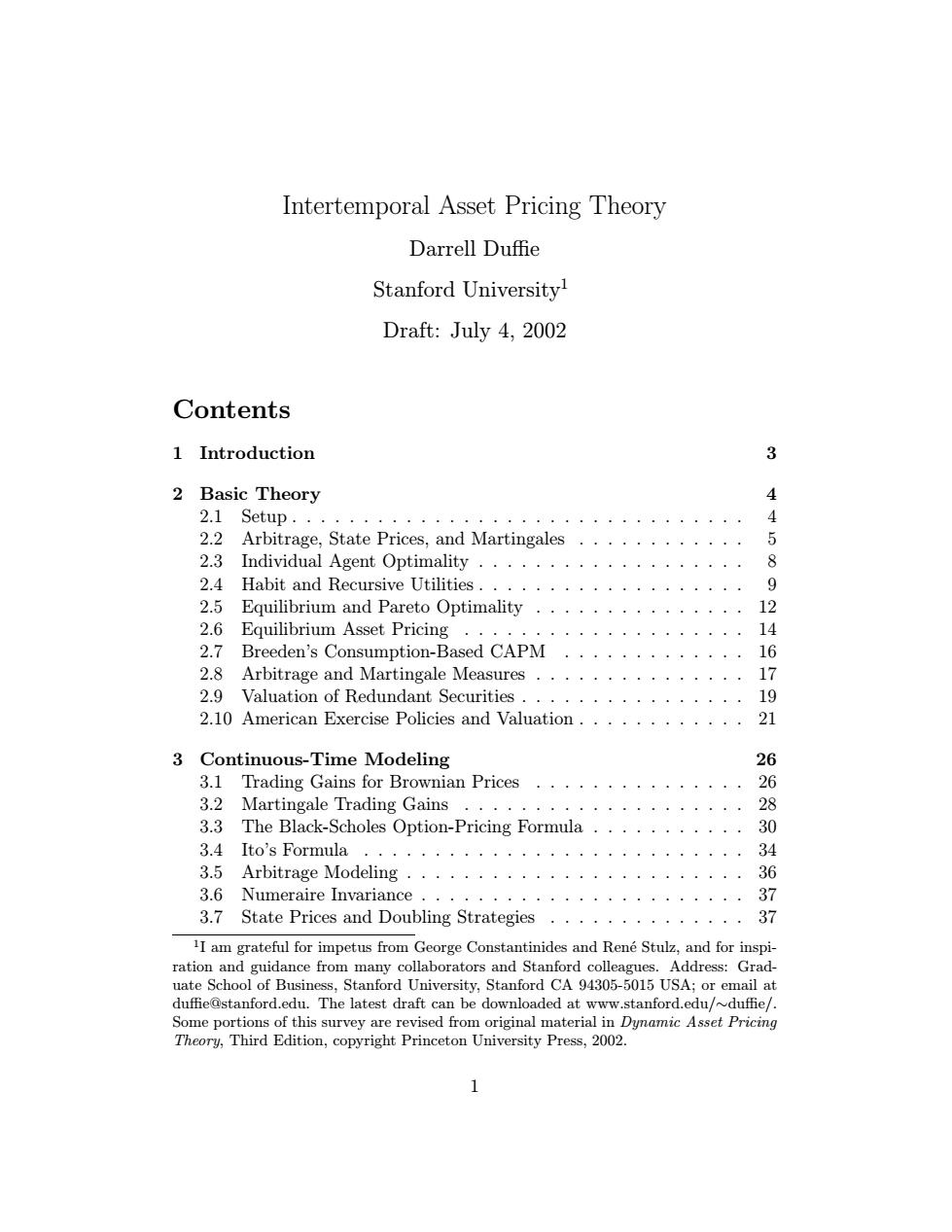正在加载图片...

Intertemporal Asset Pricing Theory Darrell Duffie Stanford Universityl Draft:July 4,2002 Contents 1 Introduction 3 2 Basic Theory 4 2.1 Setup...········· 4 2.2 Arbitrage,State Prices,and Martingales 5 2.3 Individual Agent Optimality 8 2.4 Habit and Recursive Utilities... 9 2.5 Equilibrium and Pareto Optimality 12 2.6 Equilibrium Asset Pricing...... 14 2.7 Breeden's Consumption-Based CAPM 16 2.8 Arbitrage and Martingale Measures 17 2.9 Valuation of Redundant Securities... 19 2.10 American Exercise Policies and Valuation........ 21 3 Continuous-Time Modeling 26 3.1 Trading Gains for Brownian Prices 26 3.2 Martingale Trading Gains...... 28 3.3 The Black-Scholes Option-Pricing Formula 30 3.4Ito's Formula..........····· 34 3.5 Arbitrage Modeling.···..········ 36 3.6 Numeraire Invariance............... 37 3.7 State Prices and Doubling Strategies.... 37 II am grateful for impetus from George Constantinides and Rene Stulz,and for inspi- ration and guidance from many collaborators and Stanford colleagues.Address:Grad- uate School of Business,Stanford University,Stanford CA 94305-5015 USA;or email at duffie@stanford.edu.The latest draft can be downloaded at www.stanford.edu/~duffie/. Some portions of this survey are revised from original material in Dynamic Asset Pricing Theory,Third Edition,copyright Princeton University Press,2002. 1Intertemporal Asset Pricing Theory Darrell Duffie Stanford University1 Draft: July 4, 2002 Contents 1 Introduction 3 2 Basic Theory 4 2.1 Setup . . . . . . . . . . . . . . . . . . . . . . . . . . . . . . . . 4 2.2 Arbitrage, State Prices, and Martingales . . . . . . . . . . . . 5 2.3 Individual Agent Optimality ................... 8 2.4 Habit and Recursive Utilities ................... 9 2.5 Equilibrium and Pareto Optimality . . . . . . . . . . . . . . . 12 2.6 Equilibrium Asset Pricing . . . . . . . . . . . . . . . . . . . . 14 2.7 Breeden’s Consumption-Based CAPM . . . . . . . . . . . . . 16 2.8 Arbitrage and Martingale Measures . . . . . . . . . . . . . . . 17 2.9 Valuation of Redundant Securities . . . . . . . . . . . . . . . . 19 2.10 American Exercise Policies and Valuation . . . . . . . . . . . . 21 3 Continuous-Time Modeling 26 3.1 Trading Gains for Brownian Prices . . . . . . . . . . . . . . . 26 3.2 Martingale Trading Gains . . . . . . . . . . . . . . . . . . . . 28 3.3 The Black-Scholes Option-Pricing Formula . . . . . . . . . . . 30 3.4 Ito’s Formula . . . . . . . . . . . . . . . . . . . . . . . . . . . 34 3.5 Arbitrage Modeling . . . . . . . . . . . . . . . . . . . . . . . . 36 3.6 Numeraire Invariance . . . . . . . . . . . . . . . . . . . . . . . 37 3.7 State Prices and Doubling Strategies . . . . . . . . . . . . . . 37 1I am grateful for impetus from George Constantinides and Ren´e Stulz, and for inspiration and guidance from many collaborators and Stanford colleagues. Address: Graduate School of Business, Stanford University, Stanford CA 94305-5015 USA; or email at duffie@stanford.edu. The latest draft can be downloaded at www.stanford.edu/∼duffie/. Some portions of this survey are revised from original material in Dynamic Asset Pricing Theory, Third Edition, copyright Princeton University Press, 2002. 1